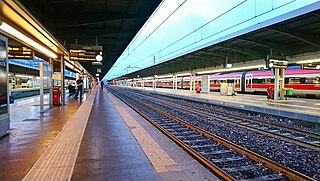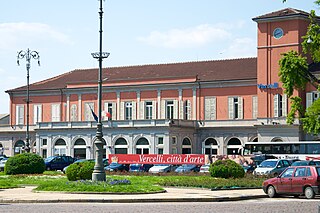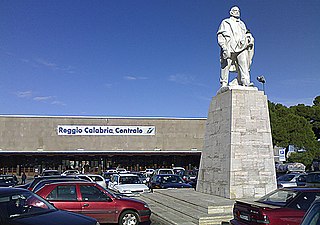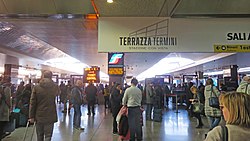
Bologna Centrale is the main railway station in Bologna, Italy. The station is situated at the northern edge of the city centre. It is located at the southern end of the Milan-Bologna high-speed line, which opened on 13 December 2008, and the northern end of three lines between Bologna and Florence: the original Bologna-Florence line through Porretta Terme and Pistoia; the Bologna–Florence Direttissima via Prato, which opened on 22 April 1934 and the Bologna-Florence high-speed line, which opened to traffic on 13 December 2009.

Roma Tiburtina is the second largest railway station in Rome, after Roma Termini. Located in the north-eastern part of the city, it was originally constructed during the 1860s as a terminal station. In recent years, the station has been redeveloped to better serve as a hub for the Italian high-speed rail services. The station is connected to Rome's Metro line B at Tiburtina metro station, as well as to local bus services via an adjacent bus depot while private vehicle users are provided with more than 100,000 spaces across multiple on-site car parks.

Venezia Santa Lucia is the central station of Venice in the north-east of Italy. It is a terminus and located at the northern edge of Venice's historic city . The station is one of Venice's two most important railway stations; the other one is Venezia Mestre, a mainline junction station on Venice's mainland district of Mestre. Both Santa-Lucia and Mestre stations are managed by Grandi Stazioni and they are connected to each other by Ponte della Libertà.

Napoli Centrale is the main railway station in the city of Naples and in southern Italy and the sixth largest station in Italy in terms of passenger flow with an annual ridership of 50 million. It is located next to Piazza Garibaldi to the east of the old city. It is the primary rail terminus and station for Naples, and serves Trenitalia national railways and EAV. This one has an underground section known as Stazione di Napoli Piazza Garibaldi, which is served by the metropolitan trains of the line 2, line 1 (Garibaldi), and 3, 12, 14, and 15 EAV Circumvesuviana lines which is accessible from 2 entrances inside the Centrale station, 1 outside in glass, and from the new Garibaldi Square.

Salerno railway station serves the Italian city of Salerno and was opened in 1866. It is the main railway station of the city.

Torino Porta Susa is a railway station in Turin, northern Italy; it is the second busiest mainline station in the city, after Torino Porta Nuova. It is located in Corso Inghilterra.

Torino Porta Nuova railway station is the main railway station of Turin, northern Italy. It is the third busiest station in Italy after Rome Termini and Milan Central, with about 192,000 journeys per day and 70 million travellers a year and a total of about 350 trains per day. Porta Nuova is a terminal station, with trains arriving perpendicularly to the facade. The station is located in Corso Vittorio Emanuele II, right in front of Piazza Carlo Felice.

Parma is a railway station serving the city of Parma, in the region of Emilia-Romagna, northern Italy. The station opened in 1859 and is located on the Milan–Bologna railway, Pontremolese railway, Brescia–Parma railway and Parma–Suzzara railway. The train services are operated by Trenitalia, Trenord and Ferrovie Emilia Romagna.

Venezia Mestre railway station is a junction station in the comune of Venice, Italy. It is located within the mainland frazione of Mestre, and is classified by its owner, Rete Ferroviaria Italiana, as a gold category station.

Padova railway station, or Padua railway station, sometimes referred to as Padova Centrale, is the main station serving the city and comune of Padua, in the Veneto region, northeastern Italy.

Novara railway station is the main station serving the city and comune of Novara, in the Piedmont region of northwestern Italy. Opened in 1854, it forms part of the Turin–Milan and is the origin point of the lines to Arona, to Alessandria, to Biella, Varallo, Domodossola and Luino.

Vercelli railway station is the main station serving the city and comune of Vercelli, in the Piedmont region, northwestern Italy. Opened in 1856, it forms part of the Turin–Milan railway, and is also a junction station for two other lines, to Valenza and Pavia, respectively.

Brindisi railway station is the main station serving the city and comune of Brindisi, in the region of Apulia, southern Italy. Opened in 1865, it forms part of the Adriatic Railway (Ancona–Lecce), and is also a junction for, and terminus of, the Taranto–Brindisi railway.

Lecce railway station serves the city and comune of Lecce, in the region of Apulia, Southern Italy. Opened in 1866, it is the southern terminus of the Adriatic Railway (Ancona–Lecce), and is also the terminus of two regional lines, the Martina Franca–Lecce railway and the Lecce–Otranto railway.

Reggio di Calabria Centrale railway station is the main railway station of the Italian city of Reggio Calabria in Calabria. It is the most important station of its region and is owned by the Ferrovie dello Stato, the national rail company of Italy.

Modena railway station is a railway station serving the city of Modena, in the region of Emilia-Romagna, northern Italy. The station opened in 1859 and is located on the Milan–Bologna railway, Verona–Modena railway and Modena–Sassuolo railway. The train services are operated by Trenitalia and Ferrovie Emilia Romagna.

Reggio Emilia is a railway station serving the city of Reggio Emilia, in the region of Emilia-Romagna, northern Italy. The station opened in 1859 and is located on the Milan–Bologna railway, Reggio Emilia–Ciano d'Enza railway, Reggio Emilia–Guastalla railway and Reggio Emilia–Sassuolo railway. The train services are operated by Trenitalia and Ferrovie Emilia Romagna.

Latina is the main railway station of the Italian city of Latina, in the region of Lazio. It is owned by the Ferrovie dello Stato, the national rail company of Italy, and is an important train station of its region.

Frecciargento is a high-speed train of the Italian national train operator, Trenitalia, as one of its Le Frecce brands. The name, which means "Silver Arrow", was introduced in 2012; these trains were previously branded as Eurostar Italia. Frecciargento trains operate at speeds of up to 250 kilometres per hour (155 mph).

Bari Centrale is the main railway station of the Italian city of Bari, capital of Apulia. It is one of the most important railway stations in Italy, with an annual ridership of 14 million.

























